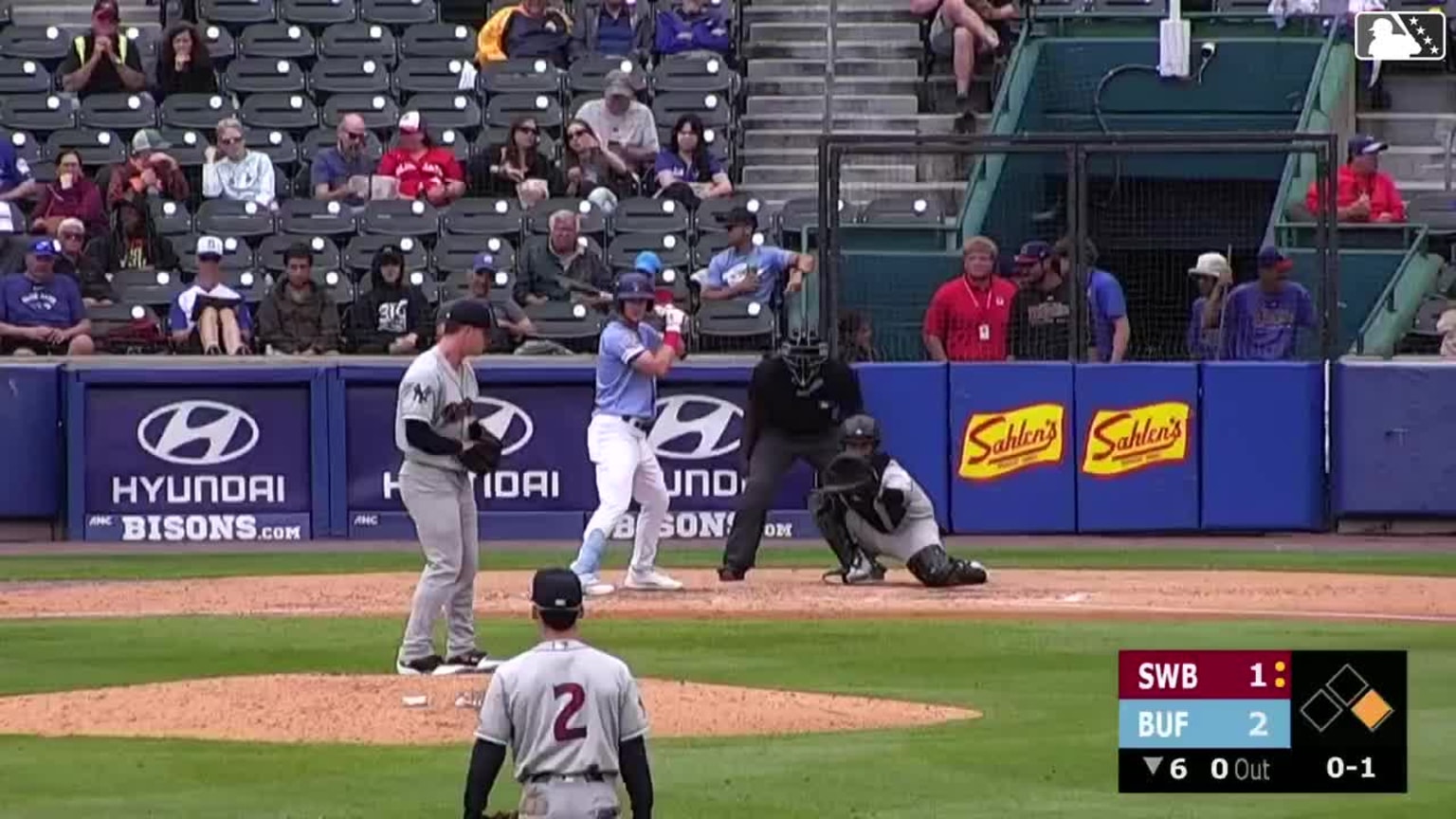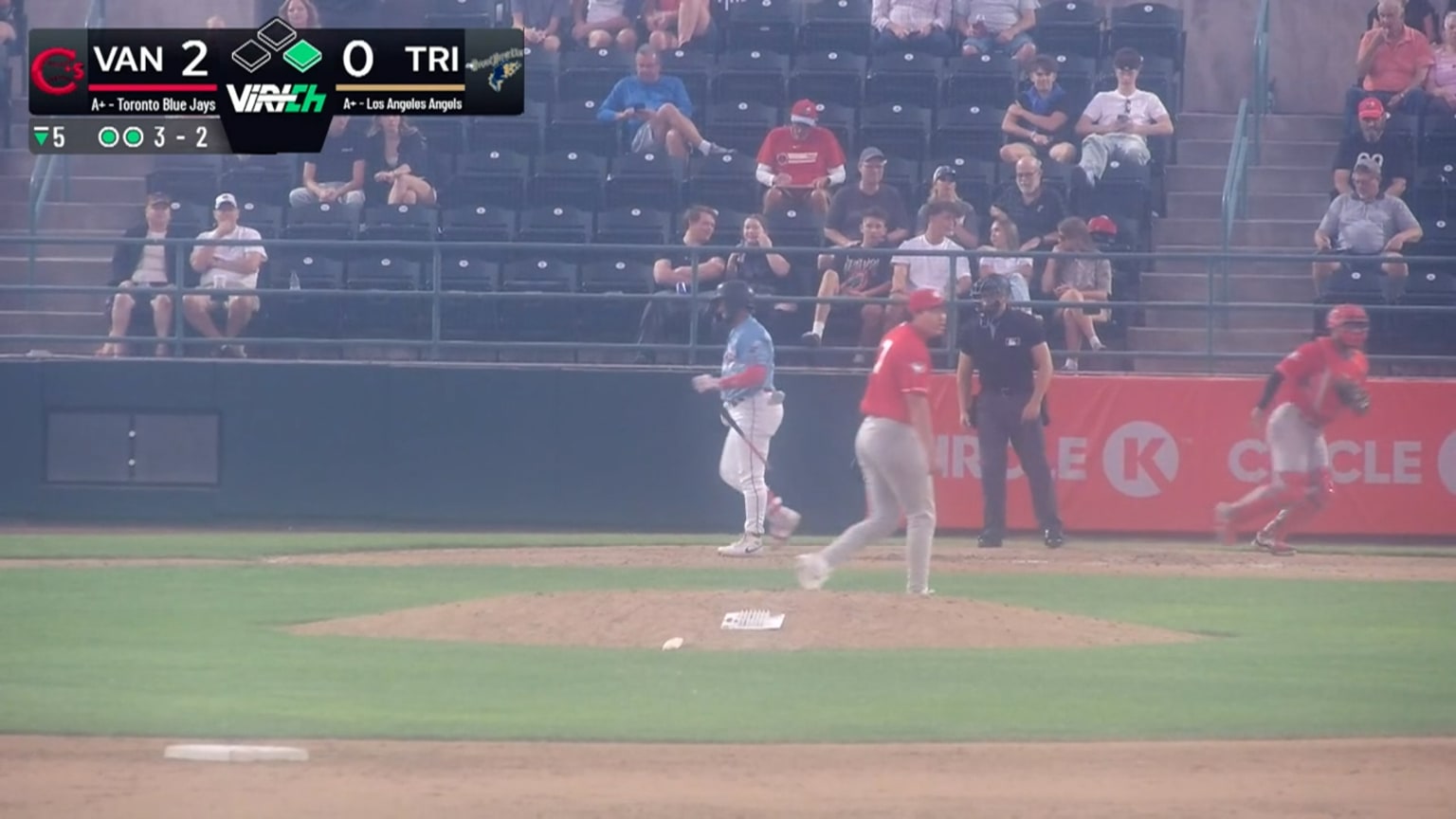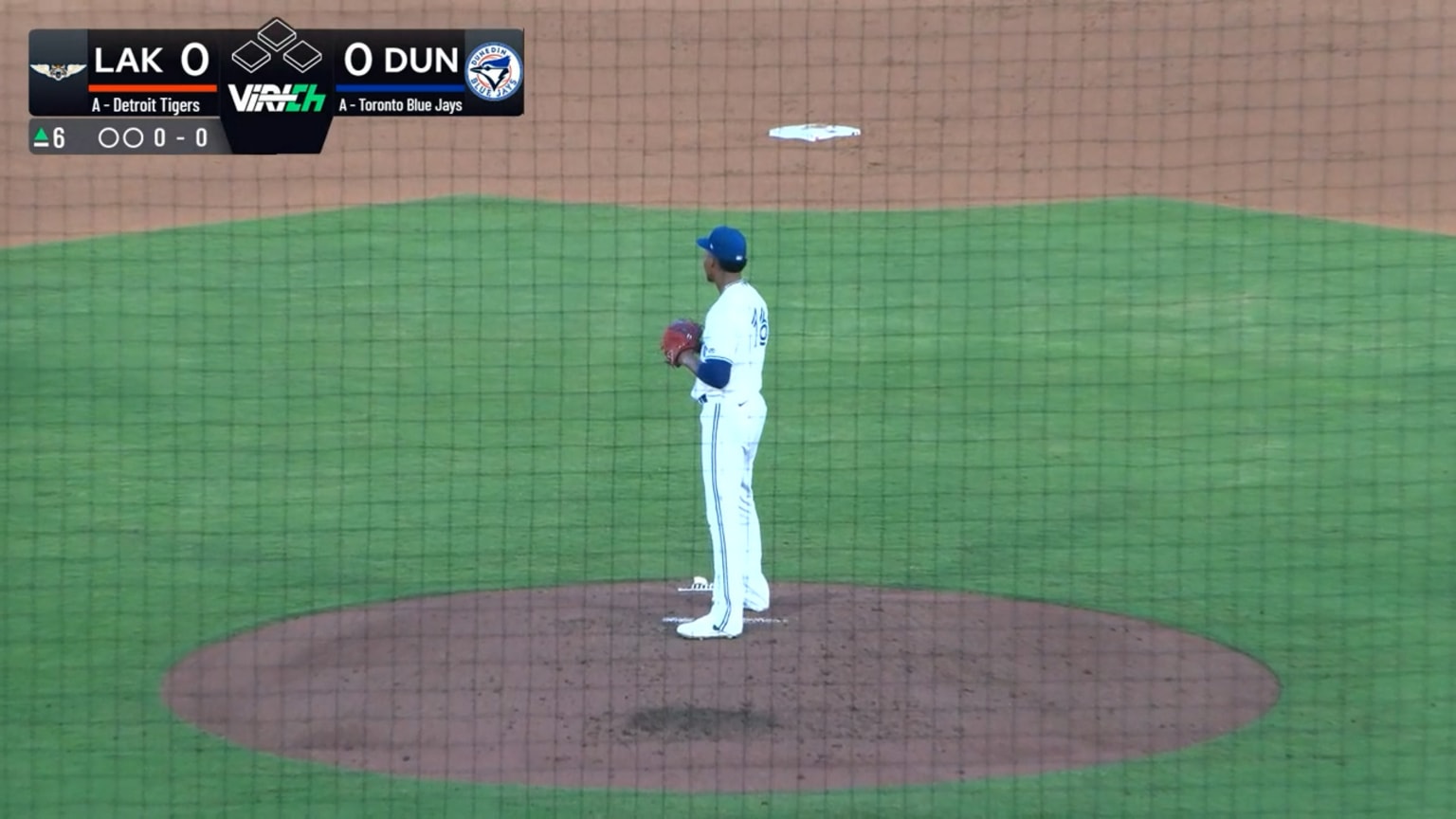- Future Blue Jays Newsletter
- Posts
- Future Blue Jays Newsletter
Future Blue Jays Newsletter
Post 40-man Deadline/Prospects 11-20
As expected, the Blue Jays added LHP Ricky Tiedemann to the 40-man roster in advance of last week’s freeze ahead of next month’s Rule 5 draft.
Starters, particularly left-handed ones who throw 95-97 (and can command that velo) do not grow on trees. Tiedemann had a minor setback in his recovery from Tommy John this summer - something that often happens, but was something the Blue Jays were very tight-lipped about. I kind of tiptoe around my sources when it comes to injuries, but usually someone will tip off something; it hasn’t happened this time around, other than it was acknowledged he hit a brief bump in the road.
Tiedemann, like many pitchers with elbow injuries, wanted to rest and rehab through it initially. That’s why it seems like forever ago that he had a breakout season. But the thing about Tommy John is that most guys are at least in much better shape when they get through the rehab process. Tiedemann is already viewed as something of a beast by the organization when it comes to that (a bit of a McDonald’s habit when he lived in the UBC dorm across the street from one when he was in Vancouver notwithstanding), so it’s exciting to think what he will be like when he’s fully recovered. And it seems like he will be come spring training.
Will he step right into the Blue Jays rotation next spring? It’s not likely. He’ll likely be ramped up at Buffalo - he might even stay behind in Dunedin for a few weeks of warm weather. One thing that sticks in my mind was something a Blue Jays player development staffer told me: younger guys (i.e., pitchers under 25) tend to take longer to get their control back after UCL surgery. Tiedemann won’t be 24 until August. The bottom line is that there’s no rush.
How about the guys left unprotected? Connor Cooke and TJ Brock, as I mentioned in the last newsletter, stand out to me. They check a few boxes for a number of organizations: Brock has a high K rate, and a walk rate under 10% if you go back to the last season he was fully healthy (2023). Cooke has pitched at AAA with some success (again, two seasons ago), although the walks are on the high side. Unfortunately (of maybe fortunately) for both, their UCL repair timelines likely won’t match up well for most organizations - the Blue Jays took RHP Angel Bastardo last year even though he underwent Tommy John himself in August of 2024. They were able to stash him on the 60-day IL for 2025, and now they can take a look at him next spring.
For pitchers who are healthy but were left unprotected, this is the type that teams would be willing to kick the tires on:
A reader asked me about OF Yohendrick Pinango, and I said his chances of being selected in the Rule 5 are slim. Fangraphs called him a “TrackMan darling” prior to the season, and on the surface there are lots of things to like: high exit velos, an ability to make contact, and good strike zone judgement. On the other hand, his 17th percentile speed limits his ability to defend, and if there’s one thing we’ve seen from the last few R5 drafts is that defence, and an ability to play multiple spots have been high on the player position shopping list (although the majority of players taken have been pitchers).
Of course, of the 15 players selected in last year’s draft, 10 were returned.
Top Prospects 11-20
Ok, let’s get down to finishing the list I started a few weeks ago (I’ve been shopping my next book, if you must know what’s taking so long).
#11 R.J. Schreck
Even coming off a trip to the World Series, there’s always room for improvement. I suspect a stiff competition for the last few roster spots, and Schreck may be in the middle of it.
Schreck had a bust-out May (at AA, earning a promotion to Buffalo) in his first full season with the Blue Jays, slashing .320/.411/.620 with 9 HRs. He missed three weeks after being hit by a pitch in June, and struggled for several weeks after his return.
In only his 3rd pro season, the former Mariners’ 9th round pick has established himself as a future fourth OF type of role player. He has an advanced plate approach, and is very much a contact-first oriented prototypical Blue Jays hitter - in addition to hitting 18 long balls at two levels, he had a 90th percentile walk rate, and his chase rate was 92nd %ile. Schreck had the best pitches/AB ration in the organization.
Schreck can play all three OF positions. He was the best hitter I saw in the organization for much of the season. I fully expect he will be on the big league roster at some point next season.
#12 Jake Bloss
With the rapid ascension of Trey Yesavage, Gage Stanifer, and the departed Khal Stephen, Bloss became something of a forgotten man in the Blue Jays pitching future, but his UCL injury was a major blow to the organization. Despite his slow start with Buffalo, the Jays were very much considering him in their plans for 2025, according to a source in the organization.
That source also suggested that maybe the Astros rushed Bloss when they promoted him to the big leagues in 2024, but he certainly pitched his way there. At 6’3”/225, Bloss has the build of an innings-eater starting pitcher. He spent time at the pitching lab in Dunedin last offseason, and looked to get off to a good start with Buffalo. Bloss sported a 10.32 ERA after his first three AAA starts, but after back-to-back solid outings at the end of April, he looked to be on his way. Then Bloss blew out his UCL a week into May, and underwent Tommy John at the end of the month.
Bloss throws primarily a mid 90s FB and sinker as part of a five-pitch arsenal, getting 87th percentile extension on the four-seamer. 2026 will be pretty much a write off for him, but he won’t turn 25 until June. He’s a sleeper at this point.
#13 Jake Cook
We have yet to see this year’s 3rd round choice in action, but if his performance at the MLB scouting combine (where he posted the best 30 yd time and longest jump) is any indication, converted pitcher Cook may be the best athlete in the organization.
Cook has speed, range and a plus (96 mph as a pitcher) arm to go with an uncanny knowledge of the strike zone and an ability to put balls in play. He draws walks, but his speed has not translated into stolen base proficiency just yet.
More of a slap hitter right now, the Blue Jays might have a steal on their hands. Unlike previous high college position player picks, he did not get a brief Florida State League trial after being drafted, which makes one wonder if there was some work to be done on his swing, or if this was an injury/wear and tear shutdown. Cook will probably begin next season in Dunedin.
The kid can flat out fly. BA has tabbed him as the leading potential breakout prospect for next season:
If Cook can add some loft and power while also improving as a baserunner, he could develop into a Jarren Duran-type hitter with better defense in the outfield. It’s a risky profile, but Cook shows supreme upside.
#14 Fernando Perez
Another guy who may have been lost due to the rise of prospects above him was Perez, who quietly added velo, and pounded the strike zone like no other pitcher in the organization. All of this added up to Perez reaching AA in August at just 21 years of age.
Perez shows an advanced feel for all five pitches in his arsenal. No one pitch stands out at this point in his career, but scouts love his pitchability and feel that his stuff will continue to grow. Certainly, continuing to add more clicks to his fastball will make his secondaries (primarily his slider) more effective. The Blue Jays have managed his progress well. His mechanics are clean, he moves the ball around, and goes right after hitters. Perez pitches to contact; much of it is of the weak variety, and hitters have a tough time putting the ball in the air against him.
His walks went up and strikeouts down slightly with the promotion to AA, which is to be expected. It’s hard to believe, but he’ll be Rule 5 eligible next fall.
#15 Silvano Hechavarria
While the Blue Jays have had their share of misses lately elsewhere in the International market, they’ve really had success with Cuban pitchers. Yosver Zulueta, Lazaro Estrada, and Rafael Sanchez have all hit the upper levels of the farm system (and beyond). Hechavarria may be the next pitcher from the island to reach those levels.
Signed in June of 2024, he was brought along slowly, pitching only in the DSL in his pro debut. This season, he pitched at 3 levels, managing just less than a strikeout per inning in 82 IP. Hechavarria was dominant at Low A, as one would expect from a 22 year old pitcher with a FB that touches 97. When he moved up to Vancouver, Hechavarria did give up more contact, but also pitched deeper into games.
Hechavarria at 6’4”/227, gets good extension from a high release point. His four-seamer has good arm side run, but it’s a pitch that he can have trouble locating. His best offering is a slider with late and sharp bite, a pitch he can use as a chase offering. He had a 21% whiff rate on it with Dunedin.
Since he’s primarily a FB/SL pitcher, it’s easy to project Hechavarria as a late-inning reliever once he’s ironed out some command issues and built his arm up. Hechavarria will pitch for Cuba at next spring’s World Baseball Classic.
#16 Sam Shaw
I present to you two stat lines from players in the system at similar stages and levels of development:
Player A

Player B

Player A is now an established big leaguer; B is still in the low minors. And they were at different ages and levels of experience because one was drafted in a round that no longer exists, but if you guessed Davis Schneider as A and Sam Shaw as B, well, my hat is off to you.
Shaw, of course, is a left-handed hitter, and like Schneider, he’s been moved around the diamond a bit as the organization tries to determine his best fit, but otherwise I think this is an apt comparison. Both are undersized players with a good knowledge of the strike zone. Schneider did not really tap into his power until he reached the upper levels of the system due to a combination of experience and time in the weight room, and I suspect Shaw will follow a similar trajectory.
Shaw spent time at Driveline last season, and it certainly showed. He morphed into more of a line drive hitter, taking advantage of a bat path that spends a lot of time in the strike zone:
Shaw shows a knowledge of the strike zone rarely seen in a player of his age and background. He’s more of a pull hitter at this point, but with more playing time, he should learn to use more of the field. After starting his career as a 2B, like Schneider, he’s moved around. Vancouver played him in CF and LF for much of his time in the NWL (he spent several weeks on the IL); he doesn’t really have the speed for the former, not the pop (yet) for the latter. But just like Davis, I think Shaw (who’s only 20) will get stronger as he moves up. You just can’t ignore a guy with his approach and swing. Other prospect lists have him lower, but I just get a feeling there’s a big league role player future ahead of him.
It’s always good to see a kid from the best side of the border do well.
#17 Josh Kasevich
2025 was going to be Kasevich’s breakout year, a season that would put him on the cusp if not in the big leagues. In 2024, he reached Buffalo, hit .325 with some pop (and only a 14% K rate), and answered a lot of questions about his bat. But a couple of things happened on his way to Toronto this season.
Kasevich’s spring was hampered by a recurrence of a back injury he’d fought his way through before. This time, surgery at the end of spring training was the only long-term solution. That put him on the shelf for the first two months of the season. In only his second game during a rehab stint with Dunedin, he collided with 3B Tucker Toman, injured his wrist, and sent him back to square one. Kasevich didn’t return to Buffalo until early August, and slashed just .173/.272/.184 in 29 International League games. Sent to the Arizona Fall League for some added reps, Kasevich hit a respectable .255 in 17 games, but none of his 14 hits were for extra bases.
Then, the injury to Bo Bichette which moved Andres Gimenez over to SS changed the dynamic of the Blue Jays infield, and Kasevich tumbled on the depth chart as a result. He was left unprotected in the Rule 5 draft, although this was a product of a mild roster crunch as much as anything. The Blue Jays are betting that issues about his bat have not been settled in the eyes of other MLB clubs. I would love to see a full return to health for him, because there’s no doubt he can play shortstop in the big leagues.
#18 Sean Keys
.217/.365/.773
That stat line from a High A player doesn’t exactly scream future big leaguer, but there’s every reason to believe Keys’ numbers will be much better at AA next season.
Keys is one of those advanced stat darlings, to wit: only a 17% O-swing rate to go along with 90th percentile average exit velo. Keys hit a lot of balls hard this season, but the more spacious Northwest League parks and Pacific air made many of them a place where doubles to the gap go to die. Here’s some more of that underlying data:
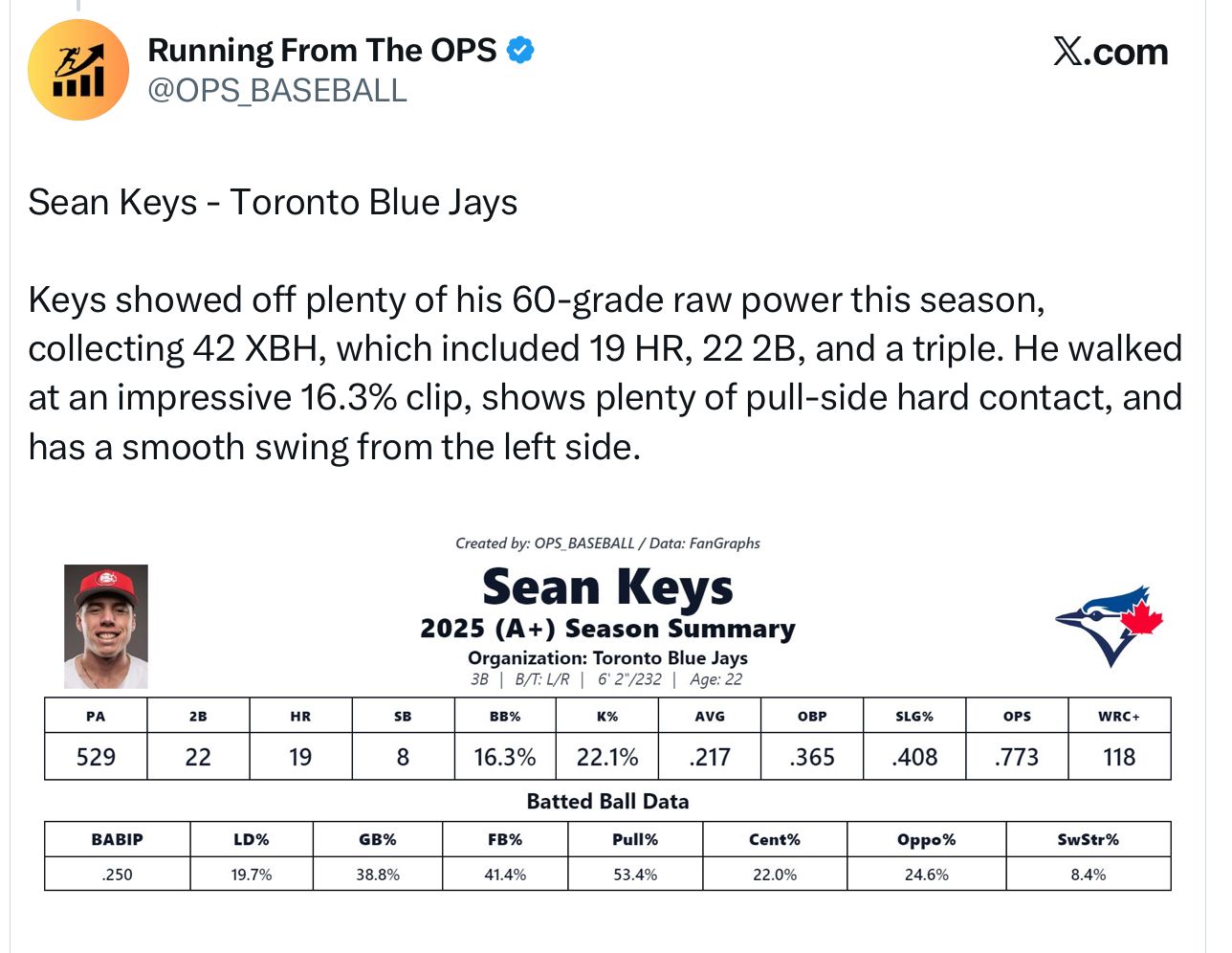
Keys had a strong (.873 OPS) second half, and set a Vancouver franchise single-season Home Run record with 19. Pipeline predicted a breakout season for him in 2025, and while that bust out didn’t happen, there’s still lots of upside here.
#19 Cutter Coffey
The Blue Jays cobbled together a decent bottom half of their lineup this season using players like Schneider, Miles Straw, Nathan Lukes, and Ernie Clement. Clement’s heir-apparent may be Coffey, who was Vancouver’s best hitter (.273/.359/.427), and followed up with a good Arizona Fall League season.
Regarded as one of the top two-way players in the 2022 draft, Coffey came over to the organization last year in the Danny Jansen deal with the Red Sox. BA says “his swing features power from the ground up,” and while his power totals (11 HR this year) have been modest to date, there still is room for projection.
Coffey can play 2B/3B/SS, although at the latter he would be more of an emergency replacement. He shows good plate discipline, and while he’s only 21, according to BA:
Coffey has the size, strength, and athleticism to become a power-hitting infielder who provides strong defense at third and fringy to average defense in the middle infield.
#20 Tim Piasentin
It’s really hard to write a scouting report on a player you haven’t seen, but I always lean toward upside, and given his Canadian connections (born in BC, played HS ball in AB), Piasentin gets the final spot on this list.
Piasentin wowed them at the scouting combine last summer, showcasing good raw power - he hit 110 mph wood bat rockets at the prospect jamboree. There is some swing-and-miss to his game, making him a bit of an outlier among Blue Jays draftees. He has the arm to remain at 3rd.
We’re going to have to wait a while to get eyes on Piasentin, who in all likelihood starts his career in the Florida Complex League next May.
Finally…..
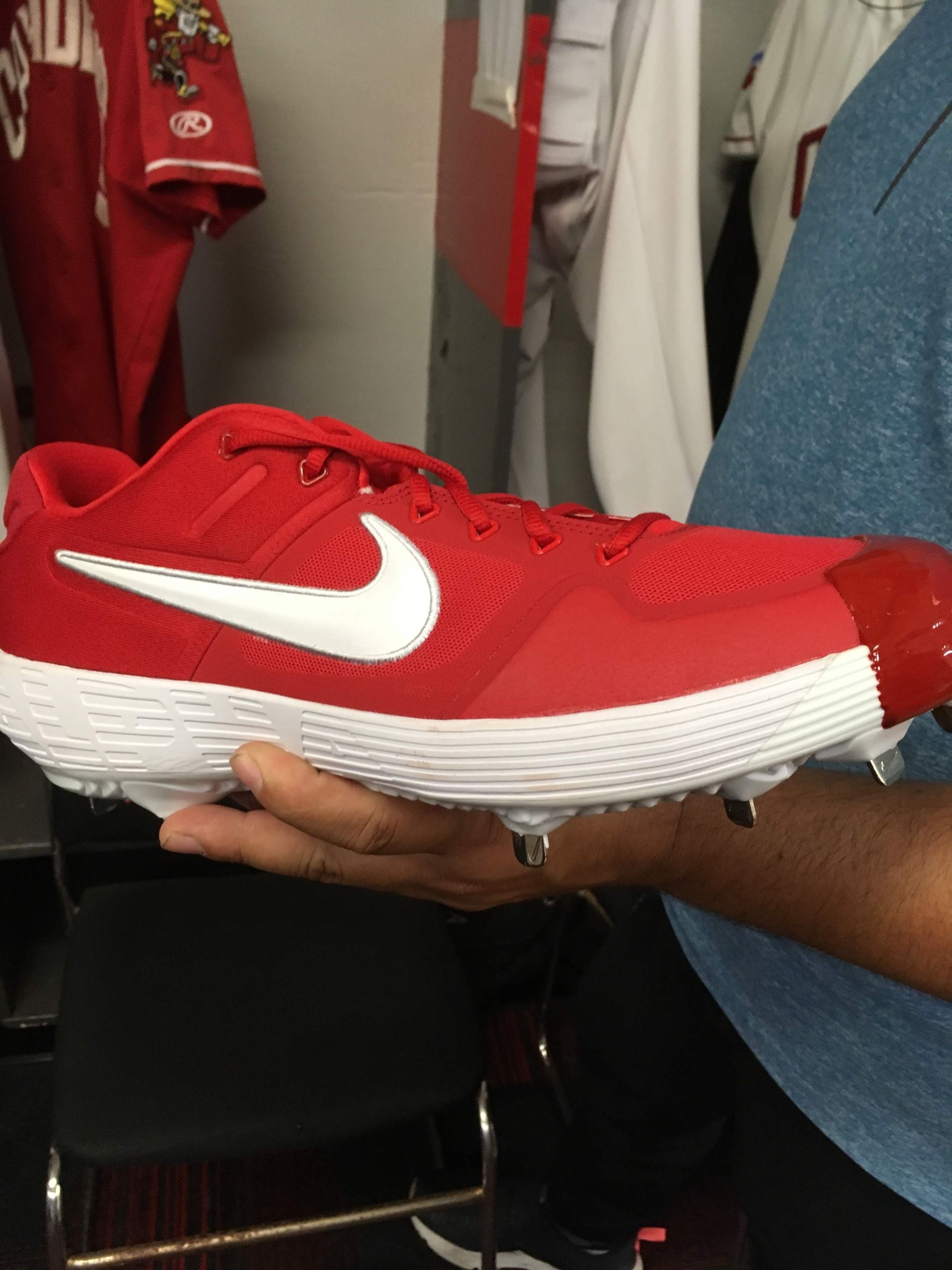
They were the biggest pair of cleats I’d ever seen.
Late in the 2019 season, when the Vancouver Canadians were only a short-season (late June to Labour Day) affiliate of the Blue Jays, I had occasion to tour the C’s clubhouse at venerable Nat Bailey Stadium with the C’s clubhouse attendant, Brighton, ON native Johnny Stewart. As we combed through the bowels of the old grandstand, Stew took me into the Canadians’ locker room (the team was on the road at the time). He showed me Alek Manoah’s size 17-and-a-half cleats, footwear that I may have been able to squeeze both of my feet into, given the chance.
News of Dylan Cease’s signing just hit my phone (thanks to my oldest son), just as I was gathering my notes and thoughts about Alek Manoah’s departure from the organization in September.
Manoah had been the Blue Jays’ first round pick, 11th overall, in the then-June 2019 MLB draft. As an advanced collegiate player, he skipped the other short-season levels to get a head start on learning to live in Canada with the British Columbia club. Manoah was brought along slowly, appearing in only 6 games for the C’s, fanning 27 overmatched Northwest League hitters in 17 innings.
COVID-19 wiped out Manoah’s 2020 season. I had wondered why - like some other pitchers in the organization - he didn’t pitch a bit of independent ball. He was held back in Dunedin when play resumed in 2021; he made just 3 starts in Buffalo before getting the call to Toronto.
We all can recall the heady days of Manaoh’s 2022 season: a memorable All Star game live-mic appearance, fanning all three hitters he faced, and a 3rd place finish in American League Cy Young voting. He looked like a lock in the front of the Blue Jays rotation for the rest of the decade, at least.
Then, it all fell apart the following year. Maybe it was the huge bump in innings pitched from the previous season, or perhaps it was related to his physical condition, but Manoah went from 2023 Opening Day starter to the Complex League in the space of ten weeks. Things went up and down, to stay the least from there, with Manoah ultimately refusing a demotion to Buffalo to finish the season, informing the club that he wouldn’t pitch again that season.
I’m sure he had his reasons, and we’ll never know the full extent of what went on, but that could not have endeared him to the front office. Looking back, it’s worth pondering what (if any) effect not pitching for a pivotal developmental season in his career had.
2024 was no better, and he underwent Tommy John surgery in June. The thing about blown out UCLs is that sometimes it’s more of a cumulative than an immediate injury, and many pitchers understandably want to try to rehab their way through it than submit to surgery, which will cost at least a season, if not more.
Manoah made his way back to Buffalo in August, where I found myself one day watching his start. While a ton of credit is due to Alek to perhaps finally taking his conditioning seriously (it’s a tremendous commitment in and out of the gym, for the more sedentary of you), it was apparent on that day that he was nowhere near ready to face big league hitters again. His velocity was down - almost 2.5 mph off his four seamer from 2022, and 2 mph off his slider. Maybe that doesn’t sound like a lot, but for a pitcher who relies more on finesse than speed, it’s a huge amount. To make matters worse, he didn’t have command of his pitches. Subsequent starts were not a whole lot better, although there were signs of progress: Manoah posted a 3.96 ERA in 10 AAA starts.
The Blue Jays surprisingly DFA’d Manoah on September 23. Many thought he would get some more runway, but obviously the front office felt differently. To be honest, some of the player development people I’ve reached out to, whose involvement was more arms-length because he was a rehabbing big leaguer, were surprised he was let go. He apparently looked good in bullpen sessions with Buffalo, but had trouble repeating his delivery in games. That was apparent to even to me that day at Sahlen Field. He was opening up and leaking out his front side, and was not on line to the plate. The one thing I did not hear from any of my sources is that he was an attitude problem, so those thinking in that direction might want to think again. Clearly, the front office felt that with 18 months to prove he could recover and pitch again, with 40-man spots at a premium (even at the back end), and with Alex turning 28 just before the start of spring training, he wasn’t going to get back to even a semblance of his 2022 form. The signing of Cease suggests that the Jays knew they were going to be active in the free agent market, so with Manoah having been surpassed on the depth chart by Trey Yesavage, with Ricky Tiedemann and Gage Stanifer close behind, maybe they thought it would be better to cut ties with Alek and allow him to seek an opportunity elsewhere. His big cleats have been more than amply filled.
That Atlanta let him go as well about a month after signing him likely was the result of the Braves wanting to get him into the organization, and then look at the numbers. They came to roughly the same conclusion as the Blue Jays.
One thing gives reason for optimism. Manoah is a much fitter version of his former self; perhaps that’s why he had trouble with his mechanics. Tommy John takes time to recover from in the first place; trying to incorporate your old mechanics into a new body can be a challenge. But being in much better shape will only help him in the long run. He’s had a rough go the past few years, and maybe has had some growing up to do. I wish him well in his comeback, wherever that is.
